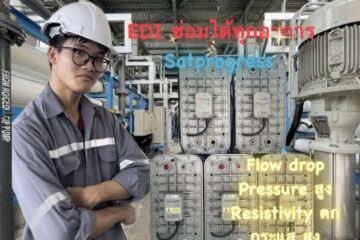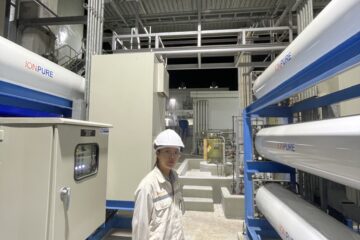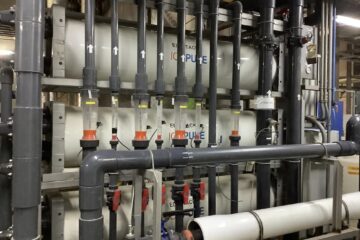Electrodeionization (EDI) is a cutting-edge technology used for producing ultra-pure water in industries like pharmaceuticals, power generation, and electronics. However, one of the most common issues that can reduce its efficiency is EDI stack fouling. This can severely impact water quality, system performance, and operational costs. Understanding the causes of fouling and implementing preventive measures is crucial to maintaining the longevity and functionality of your EDI system.
Common Causes of EDI Stack Fouling
- Biofouling
- Biofouling occurs when microorganisms such as bacteria or algae accumulate on the ion exchange membranes in the EDI stack. These organisms form a biofilm that obstructs ion transfer, reducing the efficiency of the stack. Biofouling is especially common in systems where raw water has not been adequately pre-treated or where there are issues with disinfection.
- Mineral Scaling
- Scaling happens when dissolved minerals, such as calcium, magnesium, or silica, precipitate and form solid deposits on the membranes. This occurs due to oversaturation of these ions in the water or fluctuations in pH and temperature. Scaling clogs the ion exchange channels, reducing the stack’s ability to produce high-purity water and increasing energy consumption.
- Colloidal Fouling
- Colloidal fouling results from the accumulation of fine particles like iron oxides, clays, or organic matter. These particles are usually too small to be filtered effectively in the pre-treatment process and eventually clog the ion exchange surfaces, impacting the stack’s functionality.
- Chemical Fouling
- This occurs when contaminants such as organic molecules, oils, or surfactants bind to the ion exchange membranes. Chemical fouling disrupts ion exchange and may require aggressive cleaning methods to restore the membranes’ function.
Preventive Measures for EDI Stack Fouling
- Pre-treatment Optimization
- Proper pre-treatment is key to preventing fouling in EDI systems. Pre-filtration steps like reverse osmosis (RO) can effectively remove the majority of dissolved minerals, organic matter, and other particles before they reach the EDI stack. It is also important to monitor the pre-treatment systems to ensure they are functioning correctly and to maintain appropriate water quality.
- Regular Cleaning and Maintenance
- Implementing a routine cleaning schedule for the EDI stack is essential for maintaining efficiency and prolonging the lifespan of the system. Regular cleaning of the membranes can help remove minor fouling before it becomes severe. Using appropriate cleaning chemicals that target specific types of fouling (biofouling, scaling, or colloidal deposits) is also critical.
- Biocide Application
- To combat biofouling, biocides should be applied periodically. However, care must be taken to select biocides compatible with the ion exchange membranes and to ensure that they do not negatively impact water quality. For more effective prevention, consider using a UV disinfection system in the pre-treatment stage to reduce the microbial load.
- Water Chemistry Control
- Regular monitoring and adjustment of water chemistry can significantly reduce the risk of scaling and other forms of fouling. Controlling pH, temperature, and ionic concentrations in the feed water helps minimize the precipitation of minerals and other compounds that contribute to fouling. Anti-scalant chemicals may also be used in pre-treatment to keep minerals dissolved.
- Monitor Flow Rate and Pressure
- Maintaining optimal flow rates and pressure within the EDI system can reduce the risk of fouling. Fluctuations in pressure can lead to uneven ion distribution, contributing to scaling and deposition on membranes. Regular monitoring and prompt adjustments help keep the system running smoothly.
Conclusion
Fouling in EDI stacks is an inevitable challenge, but understanding the causes and implementing preventive strategies can significantly mitigate the problem. By optimizing pre-treatment processes, maintaining water chemistry, and conducting regular cleaning, you can ensure your EDI system operates efficiently and produces high-purity water over its full operational lifespan. If you experience persistent fouling issues, consider seeking professional consultation to address system-specific challenges and identify long-term solutions.
Implement these best practices to keep your EDI system functioning at peak efficiency, avoid costly downtimes, and ensure the consistent production of high-purity water for your operations.
ทำไม EDI Stack ถึงเกิดการอุดตัน และวิธีป้องกัน
Electrodeionization (EDI) เป็นเทคโนโลยีที่ทันสมัยในการผลิตน้ำบริสุทธิ์สูงที่ใช้ในอุตสาหกรรมต่าง ๆ เช่น เภสัชกรรม การผลิตพลังงาน และอิเล็กทรอนิกส์ อย่างไรก็ตาม ปัญหาหนึ่งที่พบบ่อยในการใช้ EDI คือการเกิด การอุดตันของ EDI stack ซึ่งอาจส่งผลกระทบต่อคุณภาพของน้ำและประสิทธิภาพของระบบโดยรวม การทำความเข้าใจถึงสาเหตุของการอุดตันและวิธีป้องกันเป็นสิ่งสำคัญในการดูแลรักษาระบบ EDI ให้อยู่ในสภาพที่ใช้งานได้ยาวนาน
สาเหตุที่พบบ่อยของการอุดตันใน EDI Stack
- การสะสมของจุลินทรีย์ (Biofouling)
- การสะสมของจุลินทรีย์ เกิดขึ้นเมื่อแบคทีเรียหรือสาหร่ายสะสมตัวบนเมมเบรนแลกเปลี่ยนไอออนใน EDI stack จุลินทรีย์เหล่านี้จะสร้าง biofilm ซึ่งจะขัดขวางการส่งผ่านไอออน ส่งผลให้ประสิทธิภาพของระบบลดลง การสะสมของจุลินทรีย์มักเกิดขึ้นในระบบที่มีการบำบัดน้ำไม่เพียงพอหรือไม่มีการใช้สารฆ่าเชื้ออย่างเหมาะสม
- การสะสมของตะกรัน (Mineral Scaling)
- ตะกรัน เกิดจากการตกตะกอนของแร่ธาตุต่าง ๆ เช่น แคลเซียม แมกนีเซียม หรือซิลิก้า ซึ่งเกาะติดบนเมมเบรน การสะสมของตะกรันมักเกิดจากการที่แร่ธาตุเหล่านี้มีความเข้มข้นเกินไปในน้ำ หรือเกิดจากการเปลี่ยนแปลงของค่า pH และอุณหภูมิ การเกิดตะกรันทำให้การส่งผ่านไอออนในระบบลดลงและเพิ่มการใช้พลังงาน
- การอุดตันจากอนุภาคคอลลอยด์ (Colloidal Fouling)
- เกิดจากการสะสมของอนุภาคละเอียด เช่น ออกไซด์ของเหล็ก ดินเหนียว หรือสารอินทรีย์ อนุภาคเหล่านี้มีขนาดเล็กเกินกว่าจะกรองได้ในขั้นตอนการบำบัดน้ำล่วงหน้า และเมื่อเข้าสู่ระบบ EDI ก็จะอุดตันเมมเบรนแลกเปลี่ยนไอออน
- การอุดตันจากสารเคมี (Chemical Fouling)
- การอุดตันประเภทนี้เกิดจากการสะสมของสารอินทรีย์ น้ำมัน หรือสารลดแรงตึงผิวที่จับกับเมมเบรน ทำให้กระบวนการแลกเปลี่ยนไอออนใน EDI stack ลดลง ซึ่งอาจต้องใช้สารทำความสะอาดที่เหมาะสมในการแก้ปัญหานี้
วิธีป้องกันการอุดตันใน EDI Stack
- การปรับปรุงกระบวนการบำบัดน้ำล่วงหน้า
- การบำบัดน้ำล่วงหน้าอย่างเหมาะสม เช่น การกรองล่วงหน้าด้วย Reverse Osmosis (RO) จะช่วยกำจัดแร่ธาตุ สารอินทรีย์ และอนุภาคต่าง ๆ ก่อนที่จะเข้าสู่ EDI stack นอกจากนี้ ควรตรวจสอบระบบบำบัดน้ำอย่างสม่ำเสมอเพื่อให้แน่ใจว่าน้ำที่ผ่านเข้าสู่ EDI มีคุณภาพที่เหมาะสม
- การทำความสะอาดและบำรุงรักษาอย่างสม่ำเสมอ
- ควรมีการทำความสะอาด เมมเบรน อย่างสม่ำเสมอเพื่อป้องกันการอุดตันในระยะยาว การเลือกใช้สารทำความสะอาดที่เหมาะสมกับชนิดของการอุดตัน เช่น การสะสมของจุลินทรีย์หรือตะกรัน เป็นสิ่งสำคัญที่ช่วยยืดอายุการใช้งานของระบบ
- การใช้สารฆ่าเชื้อ (Biocide)
- การใช้ biocide เป็นวิธีหนึ่งในการป้องกันการสะสมของจุลินทรีย์ แต่ต้องเลือกสารฆ่าเชื้อที่เข้ากันได้กับเมมเบรนและไม่ทำให้คุณภาพน้ำลดลง นอกจากนี้ ควรพิจารณาใช้ระบบ UV disinfection ในกระบวนการบำบัดน้ำล่วงหน้าเพื่อช่วยลดการเติบโตของจุลินทรีย์
- การควบคุมเคมีของน้ำ (Water Chemistry)
- การตรวจสอบและปรับค่า เคมีของน้ำ อย่างสม่ำเสมอ เช่น ค่า pH อุณหภูมิ และความเข้มข้นของไอออนในน้ำ จะช่วยลดโอกาสการตกตะกอนของแร่ธาตุ นอกจากนี้ ยังสามารถใช้สารป้องกันตะกรันในกระบวนการบำบัดน้ำล่วงหน้าเพื่อป้องกันการสะสมของตะกรัน
- การตรวจสอบอัตราการไหลและความดันของน้ำ
- การรักษาอัตราการไหลและความดันของน้ำให้อยู่ในเกณฑ์ที่เหมาะสมจะช่วยลดโอกาสเกิดการอุดตันในระบบ EDI การเปลี่ยนแปลงความดันที่ไม่เหมาะสมอาจทำให้การกระจายตัวของไอออนไม่สมดุล ควรตรวจสอบและปรับปรุงการทำงานของระบบอยู่เสมอ
สรุป
การอุดตันใน EDI stack เป็นปัญหาที่หลีกเลี่ยงไม่ได้ แต่หากเข้าใจถึงสาเหตุและดำเนินการป้องกันอย่างเหมาะสมก็สามารถลดปัญหานี้ได้อย่างมาก การปรับปรุงกระบวนการบำบัดน้ำล่วงหน้า การควบคุมค่าเคมีของน้ำ และการบำรุงรักษาอย่างสม่ำเสมอเป็นสิ่งสำคัญในการรักษาประสิทธิภาพของระบบ EDI หากคุณพบปัญหาเกี่ยวกับการอุดตันในระบบ EDI ควรปรึกษาผู้เชี่ยวชาญเพื่อแก้ไขปัญหาและหาวิธีป้องกันในระยะยาว
การนำวิธีป้องกันเหล่านี้ไปใช้จะช่วยให้ระบบ EDI ทำงานได้อย่างเต็มประสิทธิภาพ ป้องกันการหยุดชะงักที่ไม่จำเป็น และผลิตน้ำบริสุทธิ์สูงได้อย่างต่อเนื่องสำหรับกระบวนการต่าง ๆ ในธุรกิจของคุณ



0 Comments